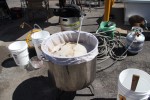 Several months ago we tackled the issue of drinkability because it was miserably hot out, and that is the sort of thing I look for when such conditions occur. Now that our Northern Hemisphere is beginning into the glorious cold parts of the year, it seemed apropos to talk about the kinds of beers I seek in such weather: big and complex. Because I largely covered the features of big beers in my high gravity article, we will focus here on complexity. Unsurprisingly, this is not going to simply be the opposite of everything in the drinkability article. Complexity and drinkability are, as previously noted, not diametrically opposed, and the methods by which they can be achieved are not always so simple as to be opposites. The major features of a complex beer should be number of flavors, balance, and spectrum. Let’s take a look at each of these features as it relates to our agenda.
Several months ago we tackled the issue of drinkability because it was miserably hot out, and that is the sort of thing I look for when such conditions occur. Now that our Northern Hemisphere is beginning into the glorious cold parts of the year, it seemed apropos to talk about the kinds of beers I seek in such weather: big and complex. Because I largely covered the features of big beers in my high gravity article, we will focus here on complexity. Unsurprisingly, this is not going to simply be the opposite of everything in the drinkability article. Complexity and drinkability are, as previously noted, not diametrically opposed, and the methods by which they can be achieved are not always so simple as to be opposites. The major features of a complex beer should be number of flavors, balance, and spectrum. Let’s take a look at each of these features as it relates to our agenda.
Number of flavors is a fairly obvious one. Regardless of other culinary achievements in a beer, nothing can be complex without multiple flavors to interact with each other. There is not a magic number. I can’t tell you that a beer won’t be complex with three flavors, and I can’t tell you that a beer will finally achieve complexity once the tenth flavor is added. There will be complex beers at varying degrees. Two general rules are that if everything a beer has to offer can be experienced in two ounces, it is not complex. Also, in this particular instance, more is better. That last part requires a caveat. More is better as long as balance and appropriate spectrum are still achieved. If things become weighted too heavily in one direction or if flavors are added that negatively interact with existing flavor components, then more is not better. High complexity is most often, but not always, found in bigger beers partly because a larger total grain bill allows more room for various additions in quantities that will be noticeable and allows for more assertive use of adjuncts, hops, and other added flavors without impairing the malt profile.
Next up is balance. I am fully aware that balance was also a necessary component of drinkability. Let that indicate how vital it is for quality beer. Complexity cannot simply equate to richness. If one flavor or one group of flavors dominates the palate to the detriment of other flavor components, then the hard work put into generating the variety of flavors has been for naught. Subtlety can be an excellent tool when pursuing complexity, but delicate flavors require a heightened attention to the details of balance. Sometimes flavors can even be so delicate as not to be recognizable as themselves but still contribute to an overall sense of complexity in a brew. For example, I once made a porter that had tiny late boil additions of molasses, chocolate extract, brown sugar, black pepper, anise, and vanilla without any of those flavors actually being evident in the beer itself. Small, subtle additions did more for the flavor of a “normal” porter than could have been achieved by boosting the amounts and making a chocolate-molasses-brown sugar-vanilla-spice porter.
Lastly, let’s spend a little time on flavor spectrum. Perhaps spectra is a more accurate term because it can, at times, be useful to utilize flavor groupings both similar to one another and those disparate but complimentary. Just like pairing theory, sometimes the best effect can be achieved by pairing similar flavors, and other times the best effect can be achieved by contrasting disparate flavors. The same principles that apply to matching foods to beers also apply to matching a larger number of flavors with a single beer. It can be effective to gather several flavors similar to each other and/or to gather disparate flavors that complement one another. To be avoided, however, is just adding additional flavors without regard to their interactions with one another. There are many flavors that can be extremely pleasant on their own that are unlikely (note: not impossible) to blend well together. Example? Sour imperial milk lager. Could be delicious. Probably vile.
Well, that felt a little labyrinthine. In review, to make a complex brew for your (or my) wintry enjoyment, keep in mind the principles of flavor number, balance, and spectra. With attention to these, your brew is more likely to achieve the coveted title of “complex”. Let me know about your favorite successes or failures of complexity right down below. Until next time, faithful readers, thanks for reading, and happy drinks!
P.S. Remember to let me know if you have some specific topic you would like me to babble about next time. You can tell me in person, by e-mail, or in the comments right down below.
Fucking Baroque
Newer PostNew West Sixth County Series Release
Older PostFlat12 Grand Opening this Saturday!





